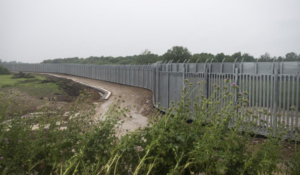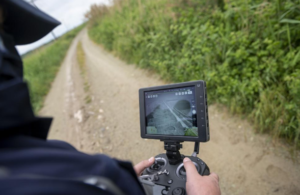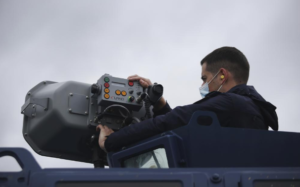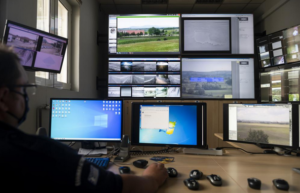As the world begins to travel again, Europe is sending migrants a loud message: Stay away!
Greek border police are firing bursts of deafening noise from an armored truck over the frontier into Turkey. Mounted on the vehicle, the long-range acoustic device, or “sound cannon,” is the size of a small TV set but can match the volume of a jet engine.

It’s part of a vast array of physical and experimental new digital barriers being installed and tested during the quiet months of the coronavirus pandemic at the 200-kilometer (125-mile) Greek border with Turkey to stop people entering the European Union illegally.
A new steel wall, similar to recent construction on the U.S.-Mexico border, blocks commonly-used crossing points along the Evros River that separates the two countries.

Nearby observation towers are being fitted with long-range cameras, night vision, and multiple sensors. The data will be sent to control centers to flag suspicious movement using artificial intelligence analysis.
“We will have a clear ‘pre-border’ picture of what’s happening,” Police Maj. Dimonsthenis Kamargios, head of the region’s border guard authority, told the Associated Press.

The EU has poured 3 billion euros ($3.7 billion) into security tech research following the refugee crisis in 2015-16, when more than 1 million people — many escaping wars in Syria, Iraq and Afghanistan — fled to Greece and on to other EU countries.

The automated surveillance network being built on the Greek-Turkish border is aimed at detecting migrants early and deterring them from crossing, with river and land patrols using searchlights and long-range acoustic devices.
Key elements of the network will be launched by the end of the year, Kamargios said. “Our task is to prevent migrants from entering the country illegally. We need modern equipment and tools to do that.”
Researchers at universities around Europe, working with private firms, have developed futuristic surveillance and verification technology, and tested more than a dozen projects at Greek borders.

AI-powered lie detectors and virtual border-guard interview bots have been piloted, as well as efforts to integrate satellite data with footage from drones on land, air, sea and underwater. Palm scanners record the unique vein pattern in a person’s hand to use as a biometric identifier, and the makers of live camera reconstruction technology promise to erase foliage virtually, exposing people hiding near border areas.
Testing has also been conducted in Hungary, Latvia and elsewhere along the eastern EU perimeter.
The more aggressive migration strategy has been advanced by European policymakers over the past five years, funding deals with Mediterranean countries outside the bloc to hold migrants back and transforming the EU border protection agency, Frontex, from a coordination mechanism to a full-fledged multinational security force.
Joint Greek-US military training “POSEIDON’S RAGE” in progress (photos)
US Delta Airlines lands in Athens becoming the 1st US company to launch flights to Greece
But regional migration deals have left the EU exposed to political pressure from neighbors.
Earlier this month, several thousand migrants crossed from Morocco into the Spanish enclave of Ceuta in a single day, prompting Spain to deploy the army. A similar crisis unfolded on the Greek-Turkish border and lasted three weeks last year.

Greece is pressing the EU to let Frontex patrol outside its territorial waters to stop migrants reaching Lesbos and other Greek islands, the most common route in Europe for illegal crossing in recent years.
Armed with new tech tools, European law enforcement authorities are leaning further outside borders.
However, not all the surveillance programs being tested will be included in the new detection system.
Source: AP
Ask me anything
Explore related questions





